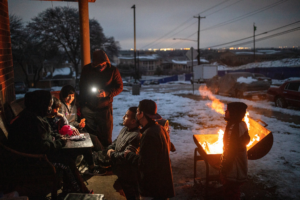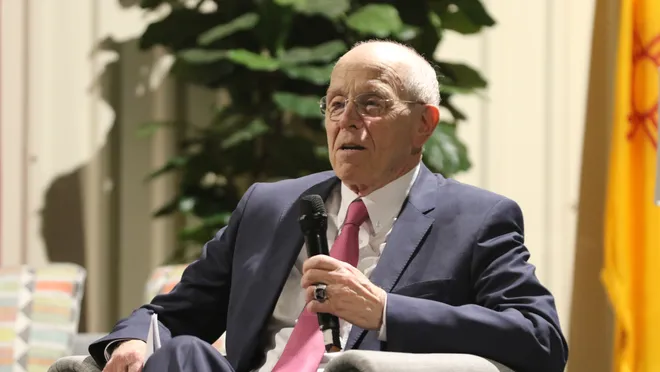 Texas has refused to join interstate electrical grids and railed against energy regulation. Now it’s having to answer to millions of residents who were left without power in last week’s snowstorm.
Texas has refused to join interstate electrical grids and railed against energy regulation. Now it’s having to answer to millions of residents who were left without power in last week’s snowstorm.
HOUSTON — Across the plains of West Texas, the pump jacks that resemble giant bobbing hammers define not just the landscape but the state itself: Texas has been built on the oil-and-gas business for the last 120 years, ever since the discovery of oil on Spindletop Hill near Beaumont in 1901.
Texas, the nation’s leading energy-producing state, seemed like the last place on Earth that could run out of energy.
Then last week, it did.
The crisis could be traced to that other defining Texas trait: independence, both from big government and from the rest of the country. The dominance of the energy industry and the “Republic of Texas” ethos became a devastating liability when energy stopped flowing to millions of Texans who shivered and struggled through a snowstorm that paralyzed much of the state.
Part of the responsibility for the near-collapse of the state’s electrical grid can be traced to the decision in 1999 to embark on the nation’s most extensive experiment in electrical deregulation, handing control of the state’s entire electricity delivery system to a market-based patchwork of private generators, transmission companies and energy retailers.
The energy industry wanted it. The people wanted it. Both parties supported it. “Competition in the electric industry will benefit Texans by reducing monthly rates and offering consumers more choices about the power they use,” George W. Bush, then the governor, said as he signed the top-to-bottom deregulation legislation.
Mr. Bush’s prediction of lower-cost power generally came true, and the dream of a free-market electrical grid worked reasonably well most of the time, in large part because Texas had so much cheap natural gas as well as abundant wind to power renewable energy. But the newly deregulated system came with few safeguards and even fewer enforced rules.
With so many cost-conscious utilities competing for budget-shopping consumers, there was little financial incentive to invest in weather protection and maintenance. Wind turbines are not equipped with the de-icing equipment routinely installed in the colder climes of the Dakotas and power lines have little insulation. The possibility of more frequent cold-weather events was never built into infrastructure plans in a state where climate change remains an exotic, disputed concept.
“Deregulation was something akin to abolishing the speed limit on an interstate highway,” said Ed Hirs, an energy fellow at the University of Houston. “That opens up shortcuts that cause disasters.”
The state’s entire energy infrastructure was walloped with glacial temperatures that even under the strongest of regulations might have frozen gas wells and downed power lines.
But what went wrong was far broader: Deregulation meant that critical rules of the road for power were set not by law, but rather by a dizzying array of energy competitors.
Utility regulation is intended to compensate for the natural monopolies that occur when a single electrical provider serves an area; it keeps prices down while protecting public safety and guaranteeing fair treatment to customers. Yet many states have flirted with deregulation as a way of giving consumers more choices and encouraging new providers, especially alternative energy producers.
California, one of the early deregulators in the 1990s, scaled back its initial foray after market manipulation led to skyrocketing prices and rolling blackouts.
States like Maryland allow customers to pick from a menu of producers. In some states, competing private companies offer varied packages like discounts for cheaper power at night. But no state has gone as far as Texas, which has not only turned over the keys to the free market but has also isolated itself from the national grid, limiting the state’s ability to import power when its own generators are foundering.
Consumers themselves got a direct shock last week when customers who had chosen variable-rate electricity contracts found themselves with power bills of $5,000 or more. While they were expecting extra-low monthly rates, many may now face huge bills as a result of the upswing in wholesale electricity prices during the cold wave. Gov. Greg Abbott on Sunday said the state’s Public Utility Commission has issued a moratorium on customer disconnections for non-payment and will temporarily restrict providers from issuing invoices.
ImageA family in Austin, Texas, kept warm by a fire outside their apartment on Wednesday. They lost power early Monday morning.
A family in Austin, Texas, kept warm by a fire outside their apartment on Wednesday. They lost power early Monday morning.Credit…Tamir Kalifa for The New York Times
There is regulation in the Texas system, but it is hardly robust. One nonprofit agency, the Electric Reliability Council of Texas, or ERCOT, was formed to manage the wholesale market. It is supervised by the Public Utility Commission, which also oversees the transmission companies that offer customers an exhaustive array of contract choices laced with more fine print than a credit card agreement.
But both agencies are nearly unaccountable and toothless compared to regulators in other regions, where many utilities have stronger consumer protections and submit an annual planning report to ensure adequate electricity supply. Texas energy companies are given wide latitude in their planning for catastrophic events.
Into a snowstorm with no reserves
One example of how Texas has gone it alone is its refusal to enforce a “reserve margin” of extra power available above expected demand, unlike all other power systems around North America. With no mandate, there is little incentive to invest in precautions for events, such as a Southern snowstorm, that are rare. Any company that took such precautions would put itself at a competitive disadvantage.
A surplus supply of natural gas, the dominant power fuel in Texas, near power plants might have helped avoid the cascade of failures in which power went off, forcing natural gas production and transmission offline, which in turn led to further power shortages.
In the aftermath of the dayslong outages, ERCOT has been criticized by both Democratic and Republican residents, lawmakers and business executives, a rare display of unity in a fiercely partisan and Republican-dominated state. Mr. Abbott said he supported calls for the agency’s leadership to resign and made ERCOT reform a priority for the Legislature. The reckoning has been swift — this week, lawmakers will hold hearings in Austin to investigate the agency’s handling of the storm and the rolling outages.
For ERCOT operators, the storm’s arrival was swift and fierce, but they had anticipated it and knew it would strain their system. They asked power customers across the state to conserve, warning that outages were likely.
But late on Sunday, Feb. 14, it rapidly became clear that the storm was far worse than they had expected: Sleet and snow fell, and temperatures plunged. In the council’s command center outside Austin, a room dominated by screens flashing with maps, graphics and data tracking the flow of electricity to 26 million people in Texas, workers quickly found themselves fending off a crisis. As weather worsened into Monday morning, residents cranked up their heaters and demand surged.
Power plants began falling offline in rapid succession as they were overcome by the frigid weather or ran out of fuel to burn. Within hours, 40 percent of the power supply had been lost.
The entire grid — carrying 90 percent of the electric load in Texas — was barreling toward a collapse.
In the electricity business, supply and demand need to be in balance. Imbalances lead to catastrophic blackouts. Recovering from a total blackout would be an agonizing and tedious process, known as a “black start,” that could take weeks, or possibly months.
And in the early-morning hours last Monday, the Texas grid was “seconds and minutes” away from such a collapse, said Bill Magness, the president and chief executive of the Electric Reliability Council.
“If we had allowed a catastrophic blackout to happen, we wouldn’t be talking today about hopefully getting most customers their power back,” Mr. Magness said. “We’d be talking about how many months it might be before you get your power back.”
Earlier warnings of trouble
The outages and the cold weather touched off an avalanche of failures, but there had been warnings long before last week’s storm.
After a heavy snowstorm in February 2011 caused statewide rolling blackouts and left millions of Texans in the dark, federal authorities warned the state that its power infrastructure had inadequate “winterization” protection. But 10 years later, pipelines remained inadequately insulated and heaters that might have kept instruments from freezing were never installed.
During heat waves, when demand has soared during several recent summers, the system in Texas has also strained to keep up, raising questions about lack of reserve capacity on the unregulated grid.
And aside from the weather, there have been periodic signs that the system can run into trouble delivering sufficient energy, in some cases because of equipment failures, in others because of what critics called an attempt to drive up prices, according to Mr. Hirs of the University of Houston, as well as several energy consultants.
Another potential safeguard might have been far stronger connections to the two interstate power-sharing networks, East and West, that allow states to link their electrical grids and obtain power from thousands of miles away when needed to hold down costs and offset their own shortfalls.
But Texas, reluctant to submit to the federal regulation that is part of the regional power grids, made decisions as far back as the early 20th century to become the only state in the continental United States to operate its own grid — a plan that leaves it able to borrow only from a few close neighbors.
The border city of El Paso survived the freeze much better than Dallas or Houston because it was not part of the Texas grid but connected to the much larger grid covering many Western states.
But the problems that began with last Monday’s storm went beyond an isolated electrical grid. The entire ecosystem of how Texas generates, transmits and uses power stalled, as millions of Texans shivered in darkened, unheated homes.
Texans love to brag about natural gas, which state officials often call the cleanest-burning fossil fuel. No state produces more, and gas-fired power plants produce nearly half the state’s electricity.
“We are struggling to come to grips with the reality that gas came up short and let us down when we needed it most,” said Michael E. Webber, a professor of mechanical engineering at the University of Texas at Austin.
The cold was so severe that the enormous oil and natural gas fields of West Texas froze up, or could not get sufficient power to operate. Though a few plants had stored gas reserves, there was insufficient electricity to pump it.
The leaders of ERCOT defended the organization, its lack of mandated reserves and the state’s isolation from larger regional grids, and said the blame for the power crisis lies with the weather, not the overall deregulated system in Texas.
“The historic, just about unprecedented, storm was the heart of the problem,” Mr. Magness, the council’s chief executive, said, adding: “We’ve found that this market structure works. It demands reliability. I don’t think there’s a silver-bullet market structure that could have managed the extreme lows and generation outages that we were facing Sunday night.”
In Texas, energy regulation is as much a matter of philosophy as policy. Its independent power grid is a point of pride that has been an applause line in Texas political speeches for decades.
Deregulation is a hot topic among Texas energy experts, and there has been no shortage of predictions that the grid could fail under stress. But there has not been widespread public dissatisfaction with the system, although many are now wondering if they are being well served.
“I believe there is great value in Texas being on its own grid and I believe we can do so safely and securely and confidently going forward,” said State Representative Jeff Leach, a Republican from Plano who has called for an investigation into what went wrong. “But it’s going to take new investment and some new strategic decisions to make sure we’re protected from this ever happening again.”
Steven D. Wolens, a former Democratic lawmaker from Dallas and a principal architect of the 1999 deregulation legislation, said deregulation was meant to spur more generation, including from renewable energy sources, and to encourage the mothballing of older plants that were spewing pollution. “We were successful,” said Mr. Wolens, who left the Legislature in 2005.
But the 1999 legislation was intended as a first iteration that would evolve along with the needs of the state, he said. “They can focus on it now and they can fix it now,” he said. “The buck stops with the Texas Legislature and they are in a perfect position to determine the basis of the failure, to correct it and make sure it never happens again.”
Source: https://www.nytimes.com/2021/02/21/us/texas-electricity-ercot-blackouts.html




0 Comments